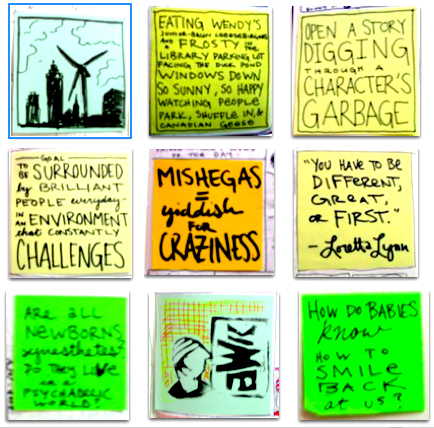
random post-its from my sketchbook
NYTimes article on Post-It notes:
In 1980, when the 3M company introduced the Post-it, no one could have foreseen the effect the 3-by-5-inch Valium-colored rectangle would have on domestic life. Its beginnings were folkloric: 40 years ago, Spencer Silver, a scientist at 3M, discovered the imperfect adhesive that would adorn the Post-it; it took another six years for Art Fry, another 3M scientist, to find the application for this half glue, which came in a flash of inspiration after the bookmarks for his church hymnal kept falling out.
Nothing is more of a blessing at work than an inexhaustible supply of Post-It notes, especially when you don’t have your sketchbook handy.
Thinking about this, hybridized with what you said in another post about outlining (or not) etc., made me recall Philip Pullman’s method for blocking out his novels: Post-Its.
Like you were talking about thumbnailing, he starts setting out a few plot points on Post-Its. Nothing fancy — just a description that will actually fit on one of them. Then he puts them in an order to see if it works, leaves gaps where he realizes something else has to come in-between, etc. I couldn’t find the place where I initially read his own take on this, but I came across this summary:
“He claims that he uses a lot of Post-It notes to write. He summarizes a scene on the smallest size of Post-Its and then attaches them to a single sheet of paper, which eventually becomes a chapter. He likes having the ability to move his scenes around as he wills.”
http://www.childrensliteraturenetwork.org/birthbios/brthpage/10oct/10-19pullman.html
So, since you enjoy *drawing* on Post-Its, and you need some other approach to blocking out your graphic novel . . .
Tim,
I should show you the “first draft” outline of this graphic novel: a huge, poster-sized sheet of paper….WITH POST-ITs AS THE SCENES!
– A
PS. Pullman’s another one of those “wanna reads”: http://www.austinkleon.com/?p=148